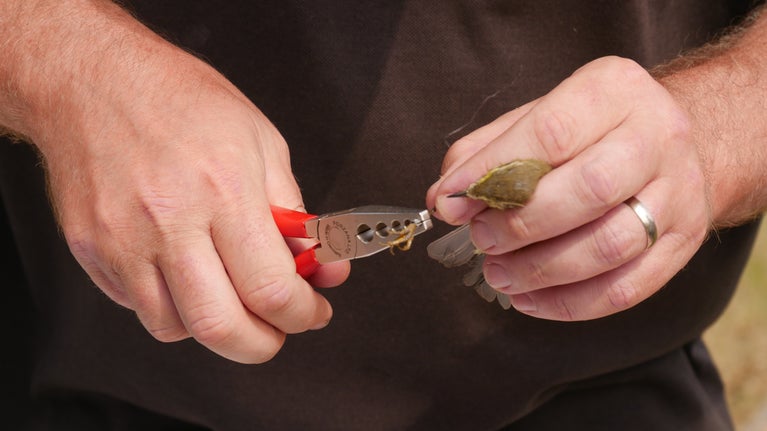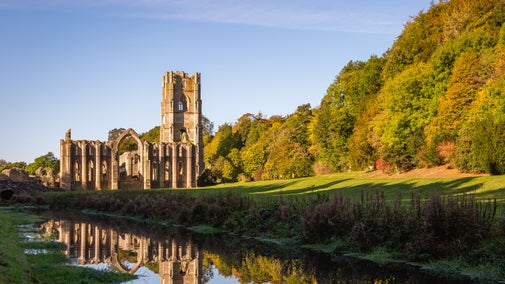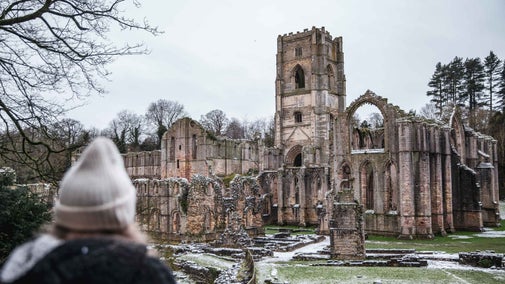
Donate
Everyone needs nature, now more than ever. Donate today and you could help people and nature to thrive at the places we care for.

From monitoring the birds swooping through the grounds and feeding at the bird hide to caring for the deer grazing throughout Studley Royal deer park, discover how the team at Fountains Abbey and Studley Royal works to support and protect the wildlife living across the estate.
The estate at Fountains Abbey and Studley Royal is rich with birdlife including goldfinches, blue tits, song thrushes, woodpeckers, geese and swans.
Around May and June each year, we check the nest boxes that we’ve installed on the estate. We also put identification rings on the legs of any new birds. Many bird species can be ringed when they're only 1–2 weeks old because their legs stay the same size through to adulthood.
We record which birds are breeding in the area, and this contributes to an overall understanding of bird populations across the country. We can see whether birds’ clutch sizes are changing, if all the eggs successfully hatch and whether all the chicks leave the nest (known as fledging).
By gathering all this information, scientists now know that there are certain species of birds that are laying their eggs earlier in the year than they did in the 1960s.
When it comes to bird conservation there are three different bands to show how well a species is doing in the UK. It's a traffic light system:
We're very excited to have recorded some marsh tits nesting on the estate in recent years. These birds are currently in the red conservation band. Keep your eyes peeled and you might see the fledglings around the estate in May.

Studley Royal deer park has a population of around 300 deer. There are three different species: red deer, fallow deer and the Manchurian sika.
Although the deer are wild, we work to make sure that the herds are safe and healthy all year round. This involves monitoring the deer to check for any signs of injury or disease, raising awareness during calving, winter feeding and responsible culling. We also maintain the park infrastructure, such as carrying out repairs to walls and fences.
The deer give birth throughout June and July, so you may see the calves if you visit during these months. The mothers like to leave their young in a nice shady spot to rest so it's perfectly normal to see a fawn or calf relaxing on their own.
Hedgehog numbers are declining fast in the UK. They’ve dropped from a population of 25 million to just 1 million over the past 50 years. We regularly find hedgehogs on the estate in the daytime. This can be a sign that the hedgehog is ill and needs some help.
When staff, visitors and volunteers find hedgehogs around the Fountains Abbey and Studley Royal estate that need some extra help we take them to HAPPY (Hedgehog Appreciation of Prickly Pals Yorkshire) or a local vets for care. If you spot one out during the day then be sure to let a member of staff know so we can come and take a look at it.
With your ongoing support, we're able to continue our vital conservation work. Thank you for helping to protect these special places.

Everyone needs nature, now more than ever. Donate today and you could help people and nature to thrive at the places we care for.
Keep up with the latest updates as the Skell Valley Project takes place, looking to create a sustainable future for the Skell Valley in North Yorkshire.

The ruins of Fountains Abbey are truly something to behold. Discover what to see when you come face to face with some of the oldest abbey ruins in the country.

The evocative ruins of the abbey are set beside the grounds of Studley Royal, a medieval deer park in Yorkshire. It was declared Yorkshire’s first World Heritage Site in 1986.

Read about our strategy, which focuses on restoring nature, ending unequal access and inspiring more people.

We believe that nature, beauty and history are for everyone. That’s why we’re supporting wildlife, protecting historic sites and more. Find out about our work.
